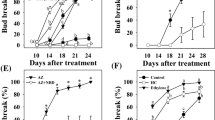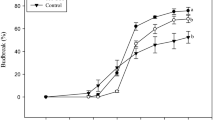Abstract
It has been reported that dormancy-breaking compound hydrogen cyanamide (HC) stimulates the fermentative pathway and inhibits respiration in grapevine-buds, suggesting in this way, that a respiratory stress must be involved in the release of buds from dormancy. Here, we tested low-oxygen effect (hypoxia) on the bud-break response of endodormant grapevine buds, and HC and hypoxia effects on the expression of hypoxic responsive genes (HRG) PYRUVATE DECARBOXYLASE (VvPDC), ALCOHOL DEHYDROGENASE (VvADH2), SUCROSE SYNTHASE (VvSUSY), non-symbiotic HEMOGLOBIN (VvnsHb), and on FLOWERING LOCUS T (VvFT), a transcription factor related to dormancy release in Vitis. Hypoxia as HC, induce transiently the expression of HRG and VvFT and hasten the sprouting of endodormant grapevine-buds. During the first 24 h after treatment, HRG and VvFT were strongly induced by hypoxia, subsequently, their expressions fell, and 14 days post-treatment increased again above control levels. These results indicate that in the short-term, a respiratory stress, caused either by oxygen deprivation or by inhibitors of respiration, induces transiently the expression of HRG and VvFT, and in the long-term, along with the advancement of bud-break, the expression of these genes move forward in treated buds, suggesting that these second induction that occurs just before bud-break is developmentally regulated.





Similar content being viewed by others
References
Bailey-Seeres J, Chang R (2005) Sensing and signaling in response to oxygen deprivation in plants and other organisms. Ann Bot 96:507–518
Bailey-Seeres J, Voesenek LA (2008) Flooding stress: acclimations and genetic diversity. Ann Rev Plant Biol 59:313–339
Chang S, Puryear J, Cairney, JA (1993) Simple and efficient method for isolating RNA from pine trees. Plant Mol Biol Rep 11:113–116
Chang WWP, Huang L, Shen M, Webster C, Burlingame AL, Roberts JKM (2000) Pattern of protein synthesis and tolerance to anoxia in root tips of maize seedlings acclimated to a low oxygen environment and identification of protein by mass spectrometry. Plant Physiol 122:295–317
Cox DR, Oaks D (1984) Analysis of survival data. Chapman & Hall, London
Dokoozlian NK, Williams LE, Neja RA (1995) Chilling exposure and hydrogen cyanamide interact in breaking dormancy of grape buds. Hortic Sci 30:1244–1247
Erez A (1987) Chemical control of bud-break. Hortic Sci 22:1240–1243
Fukao T, Bailey-Serres J (2004) Plant responses to hypoxia is a survival balancing act. Trends Plant Sci 9:449–456
Gass N, Glagotskaia T, Mellema S, Stuurman J, Barone M, Mandel T, Roessner-Tunali U, Kuhlemeier C (2005) Pyruvate decarboxylase provides growing pollen tubes with a competitive advantage in petunia. Plant Cell 17:2355–2368
Geigenberger P (2003) Response of plant metabolism to too little oxygen. Curr Opin Plant Biol 6:247–256
Gonzali S, Loreti E, Novi G, Poggi G, Alpi A, Peralta P (2005) The use of microarrays to study the anaerobic response in arabidopsis. Ann Bot 96:661–668
Halaly T, Pang X, Batikoff T, Crane O, Keren A, Venkateswari J, Ogrodovitch A, Sadka A, Lavee S, Or E (2008) Similar mechanisms might be triggered by alternative external stimuli that induce dormancy release in grape buds. Planta 228:79–88
Henzell RF, Briscoe MR, Gravett I (1991) Improving kiwifruit vine productivity with plant growth regulators. Acta Hortic 297:345–350
Hsu C-Y, Adams JP, Klim H, No K, Ma C, Strauss SH, Drnevich J, Vandervelde L, Ellis JD, Rice MD, Wickett N, Gunter LE, Tuskan GA, Brunner AM, Page GP, Barakat A, Carlson JE, dePamphilis CW, Luthe DS, Yuceer C (2011) FLOWERING LOCUS T duplication coordinates reproductive and vegetative growth in perennial poplar. PNAS 108(26):10756–10761
Keilin T, Pang X, Venkateswari J, Halaly T, Crane O, Keren A, Ogrodovitch A, Ophir R, Volpin H, Galbraith D, Or E (2007) Digital expression profiling of grape EST collection leads to new insight into molecular events during grape-bud dormancy release. Plant Sci 173:446–457
Klok EJ, Wilson IW, Wilson D, Chapman SC, Ewing RM, Somerville SC (2002) Expression profile analysis of the low oxygen response in Arabidopsis roots cultures. Plant Cell 14:2481–2494
Kühn N, Ormeño J, Jaque-Zamora G, Pérez FJ (2009) Photoperiod modifies the diurnal expression profile of VvPHYA and VvPHYB transcript in field-grown grapevines. J Plant Physiol 166:1172–1180
Lasanthi-Kudahettige Magneschi L, Loretti, Gonzali S, Licausi F, Novi G (2007) Transcript profiling of the anoxic rice coleoptiles. Plant Physiol 144:218–231
Liu F, Vantoai T, Moy L, Bock G, Linford LD, Quackenbush J (2005) Global transcription profile reveals novel insights into hypoxic response in Arabidopsis. Plant Physiol 137:387–396
Livak KJ, Schmittgen TD (2001) Analysis of relative gene expression data using real time quantitative PCR and the ΔΔCT method. Methods 25:402–408
Mustroph A, Lee SC, Oosumi T, Zanetti ME, Yang H, Ma K, Yaghoubi-Masihi A, Fukao T, Bailey-Serres J (2010) Cross-Kingdom comparison of transcriptomic adjustments to low oxygen stress highlights conserved and plant specific response. Plant Physiol 152:1484–1500
Nie X, Hill RD (1997) Mitochondria respiration and hemoglobin gene expression in barley aleurone tissue. Plant Physiol 114:835–840
Nir G, Lavee S (1993) Metabolic changes during cyanamide induced dormancy release in grapevines. Acta Hortic 329:271–274
Noriega X, Burgos B, Pérez FJ (2007) Short-day photoperiod triggers and low temperature increase expression of peroxidase RNA transcripts and basic peroxidase isoenzyme activity in grape buds. Phytochem 68:1376–1383
Ophir R, Pang X, Halaly T, Venkateswari J, Lavee S, Galbraith D, Or E (2009) Gene expression profiling of grape bud response to two alternative dormancy release stimuli expose possible links between impaired mitochondrial activity, hypoxia, ethylene-ABA interplay and cell enlargement. Plant Mol Biol 71:403–423
Or E, Vilozny I, Fennell A, Ogrodovitch A (2002) Dormancy in grape buds: isolation and characterization of catalase cDNA and analysis of its expression following chemical induction of bud dormancy release. Plant Sci 162:121–130
Pérez FJ, Lira W (2005) Possible role of catalase in post-dormancy bud-break in grapevines. J Plant Physiol 162:301–308
Pérez FJ, Rubio S, Ormeño-Nuñez J (2007) Is erratic bud-break in grapevines grown in warm winter areas related to disturbance in mitochondrial respiratory capacity and oxidative metabolism? Function Plant Biol 34:624–632
Pérez FJ, Vergara R, Rubio S (2008) H2O2 is involved in the dormancy-breaking effect of hydrogen cyanamide in grapevine buds. Plant Growth Regul 55:149–155
Pérez FJ, Vergara R, Or E (2009) On the mechanism of dormancy release in grapevine-buds: a comparative study between hydrogen cyanamide and sodium azide. Plant Growth Regul 59:145–152
Pérez FJ, Kühn N, Vergara R (2011) Expression analysis of phytochromes A, B and floral integrator genes during the entry and exit of grapevine-buds from endodormancy. J Plant Physiol 168:1659–1666
Rinne PLH, Kaikuranta PM, van der Schoot (2001) The shoot apical meristem restores its symplasmic organization during chilling induced release from dormancy. Plant J 26:249–264
Rinne PLH, Welling A, Vahala J, Ripel L, Ruonala R, Kangasjärvi, van der Schoot (2011) Chilling of dormant buds hyperinduces FLOWERING LOCUS T and recruit GA- inducible 1,3-β-glucanase to reopen signal conduits and release dormancy in populus. Plant Cell 3:130–146
Rombauts S, Dehais P, van Montagu M, Rouze P (1999) PlantCare, a plant cis-acting regulatory elements database. Nucleic Acid Res 27:295–296
Rozen S, Skaletsky H (2000) Primer3 on the www for general users and for biologist programmers. Methods Mol Biol 132:365–386
Saure MC (1985) Dormancy release in deciduous fruit trees. Hortic Rev 7:239–299
Shulman Y, Nir G, Lavee S (1983) The effect of cyanamide on the release from dormancy of grapevine buds. Scientia Hortic 19:97–104
Tadege M, Kuhlemeier C (1997) Aerobic fermentation during tobacco pollen development. Plant Mol Biol 35:345–354
van Dongen JT, Froehlich A, Ramírez-Aguilar SJ, Schauer N, Fernie AR, Erban A, Kopka J, Clark J, Langer A, Geingenberger P (2009) Transcript and metabolic profiling of the adaptative response to mild decrease in oxygen concentration in the roots of Arabidopsis seeds following low oxygen treatment. Ann Bot 103:269–280
Vergara R, Pérez FJ (2010) Similarities between natural and chemically induced bud- endodormancy release in grapevine Vitis vinifera L. Scientia Hortic 125:648–653
Acknowledgments
Financial support of Fondecyt Project 1110056 is gratefully acknowledged.
Author information
Authors and Affiliations
Corresponding author
Rights and permissions
About this article
Cite this article
Vergara, R., Rubio, S. & Pérez, F.J. Hypoxia and hydrogen cyanamide induce bud-break and up-regulate hypoxic responsive genes (HRG) and VvFT in grapevine-buds. Plant Mol Biol 79, 171–178 (2012). https://doi.org/10.1007/s11103-012-9904-3
Received:
Accepted:
Published:
Issue Date:
DOI: https://doi.org/10.1007/s11103-012-9904-3




